Living in Harmony with Nature
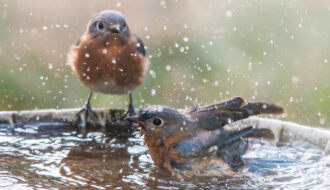
Bird Baths: The Gift of Water
Warmer weather brings sunshine, spring flowers, and beautiful bird sightings at La Piccola Villa for my clients to enjoy up close. The birdbath located in the front garden attracts all kinds of birds. Robins, mockingbirds, cardinals, Carolina wren, house finch, just to name a few. Eastern bluebirds, like these two females shown in the photo, may top the favorite list.
Birds need fresh, clean water – and you can provide it! I'd like to encourage you to offer a source of water in your own yard to help our feathered friends. Bird baths or other backyard water can be perfect for two reasons: drinking and preening. Or you can keep a bowl on your balcony or terrace. During warmer weather, water helps a bird's body stay cool both from the inside and outside. Keep the bath clean and filled with fresh, clean water. Refill as often as necessary after birds splash, or evaporation lowers the water level, otherwise small birds will not be able to drink. Offering water will attract more birds than just food sources, since birds that would not normally visit feeders can still be tempted by water features.
Help keep birds comfortable and safe!

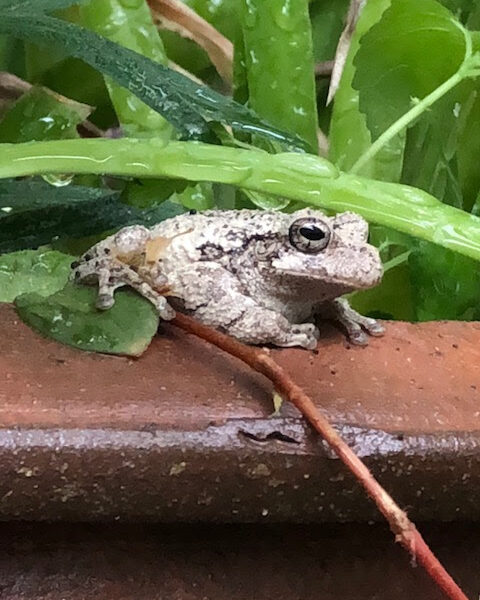
The World of Nature
Perhaps walking to the entrance of La Piccola Villa for your facial appointment, you've been serenaded by the captivating musical calls from the gray tree frogs that make my property's wildlife habitat their home. Their sounds resemble the notes made by a plucked banjo string. Sometimes these little creatures are difficult to spot among the landscape. While their name implies that they are gray, the small amphibians vary in color depending on the background in which they are presently located. Their toes are equipped with special suction-cup ends that allow these miniature vertebrates to effectively attach themselves to the surface of rough-textured tree bark.
Since ancient times, the frog has symbolized good luck, potential, prosperity, transformation, upliftment of others, and purity. With such a familiar sign of positivity, imagine my glee when I found this school of sleek, shiny tadpoles swimming in one of my water garden containers!
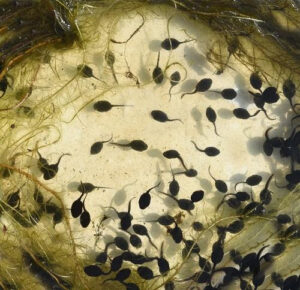
Frogs and salamanders are also considered “indicator species" by scientists to gauge the health of a local ecosystem. Keep an eye on your own home’s garden. If you provide an abundant habitat for amphibians and have a healthy population of them in and around your yard, that is a good indicator that you have a healthy environment. Whatever affects amphibians also may affect people. Stay away from synthetic pesticides, lawn chemical and mosquito sprays. Using natural alternatives gives fauna and flora in your environment a life free of toxic and harmful chemicals.
I've created my Vibrant-Glow Studio as a Nature Spa Sanctuary to express my heartfelt celebration of the natural world. Let me inspire you to become mindful of making healthier choices and starting on a pathway to toxic-free living in all aspects of your life. Nature and Nurture work together. I invite you to come experience the Nature Spa Sanctuary and relax into your natural skin's beauty with my rejuvenating holistic facial treatments.

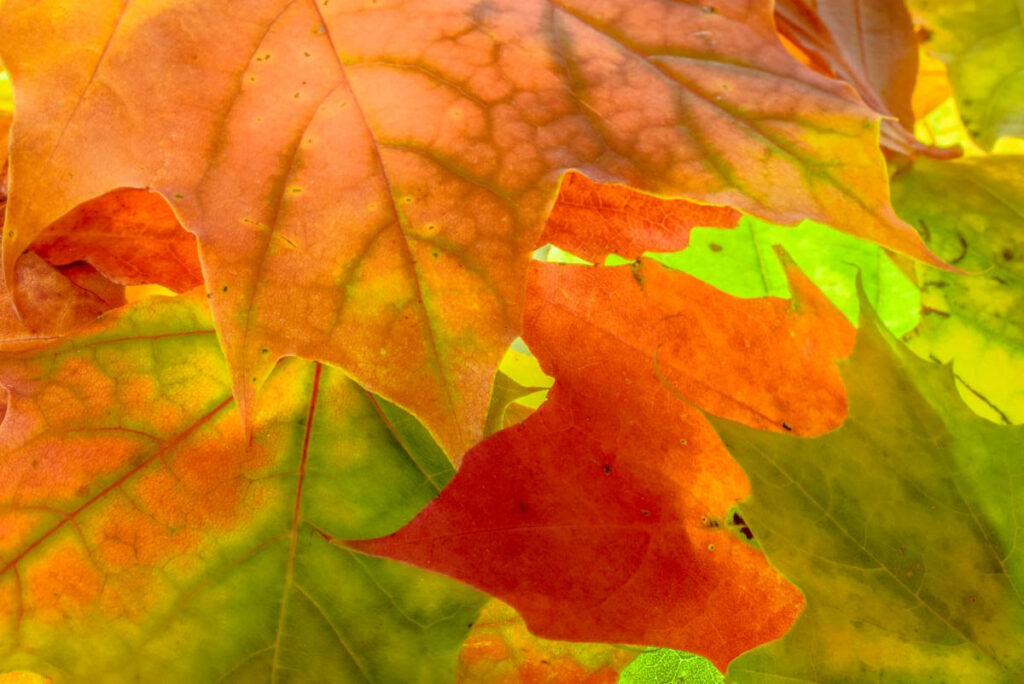
Leave The Leaves
Autumn at La Piccola Villa has always been my favorite time of the year. The weather is not too hot but not too cold. This moment is all about new beginnings as well as natural endings. In tandem with spring, autumn is part of a beautiful cycle of loss, regeneration and regrowth. As the native woodlands around my property undergo seasonal change, the landscape transforms into a palette of gorgeous fall colors.
So, what causes this magical process? During the summer, there is so much green-tinted chlorophyll in the leaves we simply cannot see the other pigments. With less sunlight, the trees prepare for winter. Their leaves stop producing chlorophyll which has allowed them to capture sunlight and make energy throughout their entire growing season. Once this happens, the green color starts to fade and the more subtle pigments of reds, oranges and yellows now become visible.
Nature is fantastic at recycling. When leaves fall to the ground, they begin to break down and eventually create a rich humus for our yards that absorbs dew and rainfall. This nutrient-rich “sponge “acts as a continual source of organic matter and water for trees and plants, helping to promote life and plant health in the next spring season.
As leaves fall down, life rises up! Let’s help Mother Nature in our neighborhoods by becoming wildlife gardeners. Besides providing the right plants and protecting our gardens from pesticides, one of the next most valuable things we can do to support pollinators and other invertebrates is to provide them with the cover they need. So many creatures evolved for millions of years to live among autumn’s fallen leaves. If you can, let your leaves remain where they have fallen naturally. Or, gently rake whole leaves into your yard’s “Wild Area” or another way that works for you—perhaps around all your trees and shrubs, lawn edges or piled in some unseen corner. When you create a habitat of fallen leaves, you’re developing an essential bit of nature where animals can safely live all year. An array of birds, small mammals and other creatures look for food and shelter in the “Wild Area” on my property at La Piccola Villa. I especially enjoy watching the brown thrashers sift through leaf litter to glean seeds, bugs and other tiny critters. There are so many animals that I discover living in the leaves—spiders, snails, worms, beetles, millipedes, mites and more—that support the chipmunks, turtles, birds and amphibians that rely on insects for food. It’s easy to see how important leaves are to sustaining the natural web of life!
While it may feel like a time of decline and natural endings, we can see that autumn is also a time of refreshment, renewal, and ultimately, optimism. Just like nature, our skin changes with the rhythms of the season. Come celebrate autumn by experiencing my Vibrant-Glow Seasonal Facial. You will enjoy a nourishing 90-minute treatment that includes skin analysis, cleansing, mineral mist, exfoliation, mask, replenishment and a massage of the head/shoulder and hand/arm areas.

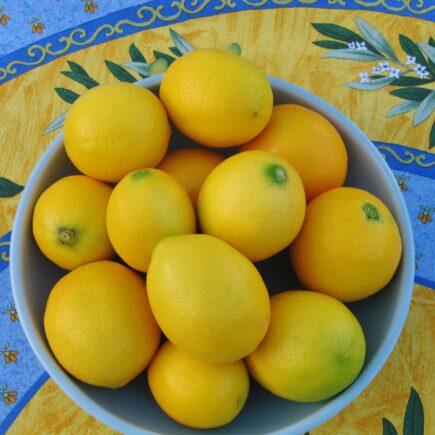
It's Meyer Lemon Season!
As many of you who have come to my spa location at La Piccola Villa for your facial treatments know, I am a fan of edible plants. The freshest foods are undeniably the healthiest. One of my favorite fruits to brighten up these dark months of winter are Meyer lemons. Years ago, while living in Northern California, I was introduced to Meyer lemons by the well-known “Mother of the Farm-to-Table Revolution,” Chef Alice Waters from Chez Panisse Restaurant, who stoked the flame of the Meyer lemon craze and helped make this special lemon very popular. The desire for these sweet, low-acid lemons with a distinctive floral fragrance have made them a must-have in the kitchen. Meyer lemons aren’t “true” lemons, but a cross between a regular lemon and a mandarin orange. Fruit is borne throughout the year, with heaviest production occurring in winter. Their skin is dark orange-yellow when ripe and they contain much more juice than traditional lemons. Because the flesh and juice are sweeter than a regular lemon, they can be used raw or cooked. I even use sections of fruit in my salad. And they are so good for your health!
You can find Meyer lemons in some specialty grocery stores and organic markets primarily from December through May. Each morning I start my day with a lemon squeezed into a quart of coconut water or filtered water for hydration and as an energizing choice to get me going. I encourage you to follow suit. Not only are the benefits of drinking lemon water endless, it’s one of the most substantial—yet one of the simplest—changes you can make to strengthen a whole host of bodily functions. Lemons are among the highest rated alkaline foods. Though acidic outside the body, they leave an alkaline ash inside the body that improves your pH balance dramatically. Lemon juice also detoxifies your blood, keeps blemishes at bay and helps to maintain your skin’s radiance. The high vitamin C content of lemons (45 mg/one lemon) assists in the production of collagen that’s essential in smoothing out lines in the face and in working to prevent wrinkles from forming. One cup of fresh lemon juice provides 187 percent of your daily recommended serving of vitamin C, and the antioxidants in lemon water fight damage caused by free radicals, helping to keep your skin looking fresh. The aroma and the skins are just as good for you! They contain natural terpenes called D-limonene that uplift mood, act as an antioxidant, and reduce inflammation. The peels are a concentrated source of this compound—a good reason to eat the peels in the form of lemon zest and pith.
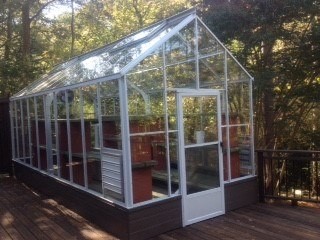
Meyer lemon plants, like other types of dwarf citrus, make nice container plants and need to be brought inside during winter in colder climates. Borrowing from Italian tradition, my glass greenhouse serves as a "limonaia" or citrus house to shelter a collection of dwarf Meyer lemons and key lime plants, as well as miniature tropical fruit trees and other non-hardy plants that need protection in a sub-tropical environment during the cold winter months. Since northern Italy's colder climate isn't citrus-friendly, Franciscan monks started building citrus houses in the 14th century to shelter the trees during winter. And, just like gardeners used to do hundreds of years ago, my care of the citrus plants, such as pruning, and fertilizing is done according to completely natural methods. Each spring, the plants of the limonaia are moved from my greenhouse and placed outdoors around the garden. Perhaps you too would like to grow the attractive and low-maintenance Meyer lemon plant and enjoy the bounty of its sweet, delicious fruit!

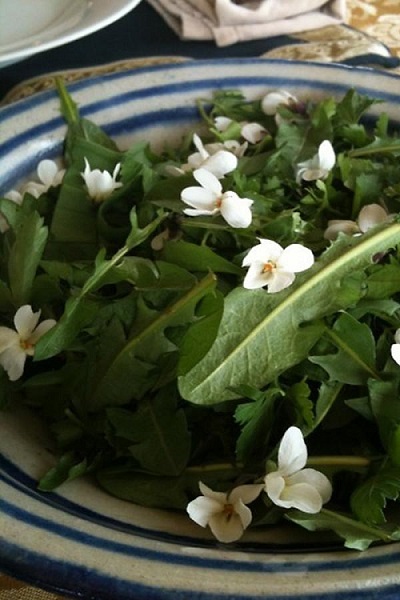
When Your Garden Gives You Weeds,
Make a Wild Green Salad!
Seeing the garden here at La Piccolla Villa come back to life in the springtime is a real joy. As a quiet escape from the hustle and bustle of city life, it’s easy to get outside to spend time in nature and notice the seasons, the calling of birds, the smell of blossoms in the air. This unique and colorful space that I now tend doesn’t seem like something I own but more of an honored custodianship. Plants are restful to look at as I enjoy my selection of edible fruit bushes and flowering perennials that have sprung to life in recent weeks.
But the warm spring weather also brings with it a few plants that might not be considered quite as desirable in the yard – weeds. We have all been conditioned to make gardens with an emphasis on aesthetics. Weeds have an unfavorable reputation that fuels the idea that a well-manicured garden reflects the most attractive locations and boosts property value with its curb appeal. However, as a Nature Lover, I find myself pushing back against my own fixation to keep things looking “just so” at the expense of not fully supporting the needs of wildlife. Nature is messy. Perhaps many of the wildflower so-called weeds should be considered the ‘unsung heroes’ in our gardens. Ecological systems are full of variation. The more diversity in the flora and fauna in it, the more resilient and healthier it is. Weeds can be characterized as any specimen that a gardener feels is an unwelcome and annoying plant. While flora such as wild violets can technically be considered weeds, I appreciate the hints of color they can provide for the yard. So how to decide which one is a weed, and which one is a flower, when some weeds are beautiful? It’s influenced by the norms and culture we grow up in. Because of this, perceptions about common weeds, like dandelions or clover, are largely based on our own opinion. They may have smaller flowers than the garden varieties, but they bring so much life (and wildlife!) into the garden. The definition of a weed depends entirely upon whether we want the plants in question. We decide which is a weed and which isn’t.
But wait! Don’t toss weeds in the compost pile just yet – you might be able to use some of them for a fresh, colorful spring salad. Chances are that some of those untamed plants are not only edible but also delicious and healthy for you. Wild greens are not the watery lettuce from the supermarket. There are flavors and nutrients in wild foods that come from being untended, and some of our palates may not be initially familiar with these somewhat bitter flavors. It’s helpful to remember that our palates are always changing, and you’ll soon come to love new flavors over a short amount of time.
Before harvesting weeds, make sure you confirm the identity and health effects of any and all plants before consuming them. The Extension Gardener Plant Toolbox from NCSU PLANT GUIDE
The Extension Gardener Plant Toolbox from NC State which contains detailed descriptions and photographs of more than 4,000 plants that grow in and around our Southern region, is an excellent resource to help with plant identification and safety information. Steer clear of plants that could have been sprayed with garden chemicals or that grow near roads or railroad tracks.
Here are some of my Yard to Salad Bowl favorites:
Dandelions: Leaves and blossoms are edible
Chickweed: Leaves, flowers and stems are edible
Sorrel: Leaves are edible
Wild Violets: Flowers are edible
Wild Mustards: Leaves, buds, flowers, and young seedpods are edible
Wild Garlic: Leaves are edible
Lambs Quarters: Leaves and stems are edible
Plantain: Leaves and seeds are edible
Purslane: Leaves, stem, flowers, and seeds
Red Clover: Flowers
Let’s make our gardens more wildlife friendly as well as discover that a yummy salad may be hiding in plain sight. Perhaps now that we know that some weeds that we pull from our garden are as tasty as the veggies we grow, we’ll have the start referring to them as volunteer vegetables instead of weeds. As Ralph Waldo Emerson reminds us, “A weed is only a plant whose virtues have not yet been discovered!”

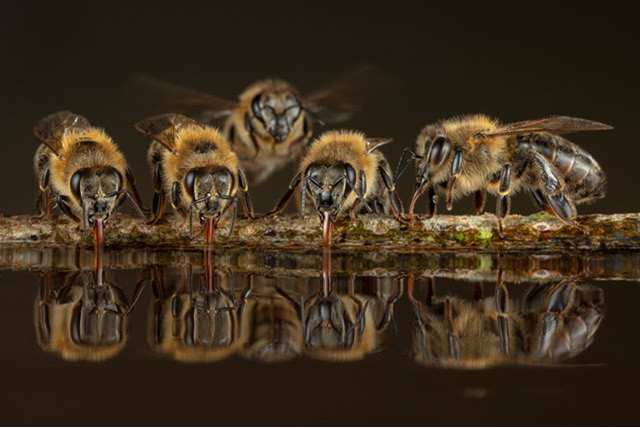
Let’s Be There For BEES
Nowadays, here at La Piccola Villa, the flight of bees never fails to grab my attention. One of the first things I noticed about these flying insects is that they are extremely industrious. They can be seen before many trees have even leafed out in March and are still around seven months later in October when the leaves are changing color. For the past few months, I’ve marveled at how long and hard they toil collecting pollen and nectar from flowers in my garden. They begin early in the morning, much earlier than most other wild pollinators are flying. At the close of the day, they are still hard at work long after other insects have settled in for the night. During their extended workday, they visit more flowers and collect more pollen and nectar than other insects. Did you know that bees pollinate both our crops and wild plants, providing us with one-third of the food we eat and allowing wild plants to reproduce the berries, fruits, seeds, and other plant foods that form the base of the natural food web? Both honeybees and native wild bees play a vital role in our ecosystem, yet they’re vanishing due to pollution, parasites, diseases, exposure to pesticides, and climate change. My observations of bees in my garden, coupled with learning more about them, have transformed me into a great admirer of these buzzing insects. If you take the time to watch these valuable wildlife neighbors work the flowers in your backyard, I am certain you will want to join me by doing more to help them thrive.
Here are a few tips to attract bees to your garden:
Start by planting and maintaining a select variety of bee friendly plants that produce nectar- and pollen-producing flowers for your garden that bloom early spring to late fall. Native plants are best because they require less maintenance, have coevolved with indigenous bees, and reliably produce nectar and pollen. Wildflowers are a great option for those who want to attract bees but don’t want a garden of flowers to maintain. They are easier to grow than cultivated varieties and they provide an important food source for bees during the spring when other flowers are not yet in bloom. Plants like coneflowers, milkweed, phlox, and bee balm are great choices for your yard.
Don’t stress about weeding. Weeds are bee magnets! Dandelions, clover, and other so-called “weeds” are actually early blooming flowers that provide an important source of food for bees as they emerge from hibernation in spring.
Create a Bee Lawn. Want to know how you can mow significantly less often and help native pollinators? My Bee Lawn is a mix of grass and Dutch white clover that grows only 2 to 8 inches tall. The mild, pleasant-smelling blossoms provide a much-needed food resource of both nectar and pollen for bees. Plus, it stays green and healthy all year without the use of fertilizer. I also recommend avoiding insecticides (which kill bees directly) and herbicides (which kill the plants bees depend on), especially when plants are in bloom and bees are out foraging.
Bees are thirsty! It's easy to provide bee watering stations by putting out shallow basins of fresh water. Rocks, stones, pebbles, gravel, marbles, sticks, and corks are some of the things you can use to provide a safe harbor for bees to access the water without slipping in. Choose a spot that is visible but out of the way of high traffic areas of the yard. Placing it in the garden, near flowers bees find delectable, will also help them locate your water source. Replace the water at least once per week, and much more frequently during those really hot and sizzling days.
Ensure bees have nesting sites too. In contrast to hive-dwelling honeybees, most native bees nest alone in small holes on open, sandy ground or in brush piles, tree snags, logs, or excavated twigs. To help preserve nesting sites, leave bare patches of soil and, if safe, fallen logs or dead trees. You may also supplement such natural nest sites with bundles of hollow plant stems or wooden mason-bee houses. Reduce mulching, mowing, and tilling that may destroy nests or future nesting sites.
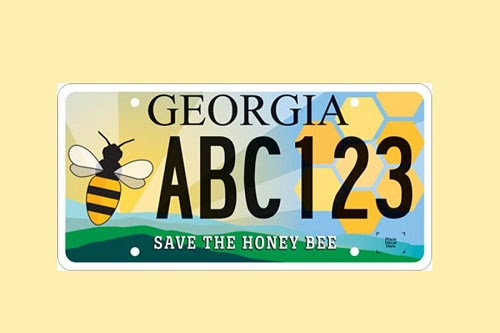
Get Your Save The Honey Bee License Plate Here:
Georgia Department of Motor Vehicles Bee License Application
Georgia Beekeepers Association is proud to offer the Save The Honey Bee license plate to Georgia drivers so they can show their support of local pollinators while on the road. Each license plate sold helps to educate local beekeepers and the public about honeybees and the importance of pollinators, as well as supports research on honeybee health.
Lastly, Here’s Something to Consider: Do Bees Recognize Faces?
Recognizing faces is essential for how we as humans interact and is often thought to be an ability that requires the sophistication of the large human brain. But according to the Beesource Beekeeping Forum, recent new evidence has emerged that bees use visual processing mechanisms that are similar to humans’, enabling reliable face recognition.
The brain of a honeybee has a million neurons. This is very few, compared to the 100 billion neurons in the human brain. Research has reported that bees can recognize faces and do it in the same way humans do!
Bees use a technique called configural processing, piecing together the components of a face: eyes, ears, nose, and mouth. They then form a recognizable pattern based on the differences of these facial components.
Bees are famous for their pattern-recognizing abilities, which scientists believe evolved over the years to discriminate among flowers in the wild. Bees are social insects, and they can also tell apart their hive mates. It is only logical that bees can identify human faces if they can recognize different bees in their hive.
Bees are like the humans who take good care of them. Because it has been established that bees can detect and recognize human faces, it has been noticed that they can even build trust with their human caretakers!
Hmm...I wonder! Let’s give helping bees our best effort.